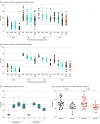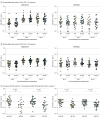Durability of Heterologous and Homologous COVID-19 Vaccine Boosts
- PMID: 35947380
- PMCID: PMC9366542
- DOI: 10.1001/jamanetworkopen.2022.26335
Durability of Heterologous and Homologous COVID-19 Vaccine Boosts
Abstract
Importance: Antibody responses elicited by current messenger RNA (mRNA) COVID-19 vaccines decline rapidly and require repeated boosting.
Objective: To evaluate the immunogenicity and durability of heterologous and homologous prime-boost regimens involving the adenovirus vector vaccine Ad26.COV2.S and the mRNA vaccine BNT162b2.
Design, setting, and participants: In this cohort study at a single clinical site in Boston, Massachusetts, 68 individuals who were vaccinated at least 6 months previously with 2 immunizations of BNT162b2 were boosted with either Ad26.COV2.S or BNT162b2. Enrollment of participants occurred from August 12, 2021, to October 25, 2021, and this study involved 4 months of follow-up. Data analysis was performed from November 2021 to February 2022.
Exposures: Participants who were previously vaccinated with BNT162b2 received a boost with either Ad26.COV2.S or BNT162b2.
Main outcomes and measures: Humoral immune responses were assessed by neutralizing, binding, and functional antibody responses for 16 weeks following the boost. CD8+ and CD4+ T-cell responses were evaluated by intracellular cytokine staining assays.
Results: Among 68 participants who were originally vaccinated with BNT162b2 and boosted with Ad26.COV2.S (41 participants; median [range] age, 36 [23-84] years) or BNT162b2 (27 participants; median [range] age, 35 [23-76] years), 56 participants (82%) were female, 7 (10%) were Asian, 4 (6%) were Black, 4 (6%) were Hispanic or Latino, 3 (4%) were more than 1 race, and 53 (78%) were White. Both vaccines were found to be associated with increased humoral and cellular immune responses, including against SARS-CoV-2 variants of concern. BNT162b2 boosting was associated with a rapid increase of Omicron neutralizing antibodies that peaked at a median (IQR) titer of 1018 (699-1646) at week 2 and declined by 6.9-fold to a median (IQR) titer of 148 (95-266) by week 16. Ad26.COV2.S boosting was associated with increased Omicron neutralizing antibodies titers that peaked at a median (IQR) of 859 (467-1838) week 4 and declined by 2.1-fold to a median (IQR) of 403 (208-1130) by week 16.
Conclusions and relevance: Heterologous Ad26.COV2.S boosting was associated with durable humoral and cellular immune responses in individuals who originally received the BNT162b2 vaccine. These data suggest potential benefits of heterologous prime-boost vaccine regimens for SARS-CoV-2.
Conflict of interest statement
Figures



Similar articles
-
Humoral and cellular immunogenicity of homologous and heterologous booster vaccination in Ad26.COV2.S-primed individuals: Comparison by breakthrough infection.Front Immunol. 2023 Mar 7;14:1131229. doi: 10.3389/fimmu.2023.1131229. eCollection 2023. Front Immunol. 2023. PMID: 36960070 Free PMC article.
-
Comparison of antibody response durability of mRNA-1273, BNT162b2, and Ad26.COV2.S SARS-CoV-2 vaccines in healthcare workers.Int J Infect Dis. 2022 Oct;123:183-191. doi: 10.1016/j.ijid.2022.08.022. Epub 2022 Aug 28. Int J Infect Dis. 2022. PMID: 36044963 Free PMC article.
-
Differential immunogenicity of homologous versus heterologous boost in Ad26.COV2.S vaccine recipients.Med. 2022 Feb 11;3(2):104-118.e4. doi: 10.1016/j.medj.2021.12.004. Epub 2022 Jan 19. Med. 2022. PMID: 35072129 Free PMC article.
-
Immunogenicity and efficacy of Ad26.COV2.S: An adenoviral vector-based COVID-19 vaccine.Immunol Rev. 2022 Sep;310(1):47-60. doi: 10.1111/imr.13088. Epub 2022 Jun 11. Immunol Rev. 2022. PMID: 35689434 Free PMC article. Review.
-
T and B cell responses in different immunization scenarios for COVID-19: a narrative review.Front Immunol. 2025 Mar 18;16:1535014. doi: 10.3389/fimmu.2025.1535014. eCollection 2025. Front Immunol. 2025. PMID: 40170841 Free PMC article. Review.
Cited by
-
Mechanistic models of humoral kinetics following COVID-19 vaccination.J R Soc Interface. 2025 Jan;22(222):20240445. doi: 10.1098/rsif.2024.0445. Epub 2025 Jan 29. J R Soc Interface. 2025. PMID: 39876790 Free PMC article.
-
Covid-19 Vaccines - Immunity, Variants, Boosters.N Engl J Med. 2022 Sep 15;387(11):1011-1020. doi: 10.1056/NEJMra2206573. Epub 2022 Aug 31. N Engl J Med. 2022. PMID: 36044620 Free PMC article. Review. No abstract available.
-
Augmenting Vaccine Efficacy against Delta Variant with 'Mycobacterium-w'-Mediated Modulation of NK-ADCC and TLR-MYD88 Pathways.Vaccines (Basel). 2023 Feb 1;11(2):328. doi: 10.3390/vaccines11020328. Vaccines (Basel). 2023. PMID: 36851206 Free PMC article.
-
Heterologous versus homologous boosting elicits qualitatively distinct, BA.5-cross-reactive T cells in transplant recipients.JCI Insight. 2023 May 22;8(10):e168470. doi: 10.1172/jci.insight.168470. JCI Insight. 2023. PMID: 37104041 Free PMC article.
-
Strong SARS-CoV-2 T-Cell Responses after One or Two COVID-19 Vaccine Boosters in Allogeneic Hematopoietic Stem Cell Recipients.Cells. 2022 Sep 27;11(19):3010. doi: 10.3390/cells11193010. Cells. 2022. PMID: 36230971 Free PMC article.
References
Publication types
MeSH terms
Substances
Supplementary concepts
Grants and funding
LinkOut - more resources
Full Text Sources
Medical
Research Materials
Miscellaneous

